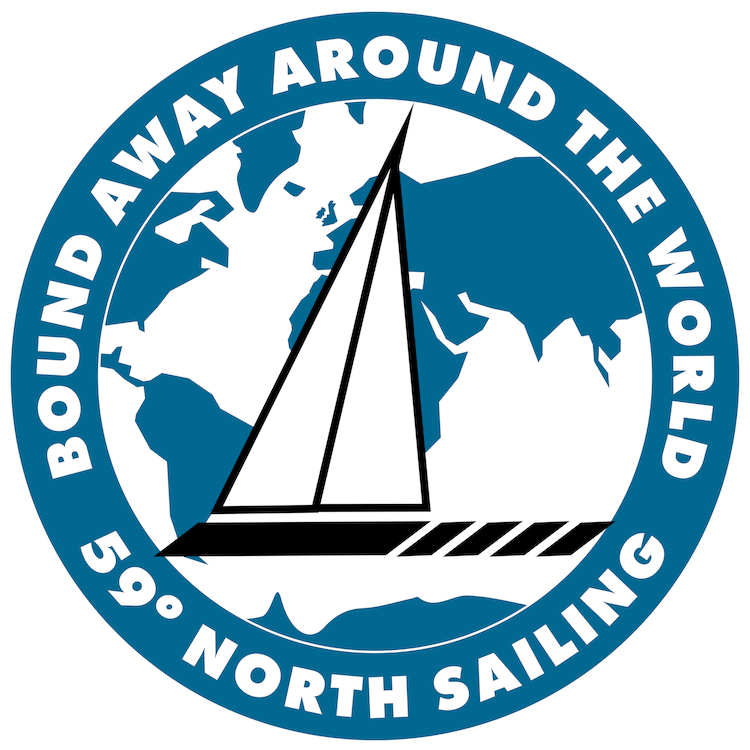The 'fushing' harbor in Stromness, the other town on Mainland.
Yesterday’s weather was Scottish! We awoke to a steady drizzle, the decks soaked and the dock covered in puddles. By noon the sun was out, but the temperature had plummeted. A few hours later, the sun remained, but the air was warm, folks in town walking the streets of Kirkwall wearing t-shirts. By dinnertime, the fog had rolled in and you couldn’t see the end of the dock.
I went for a run while Mia cooked dinner, following the road along the waterfront that wound it’s way towards the east and out of town. The atmosphere was ‘close’, warm enough for shorts, but still chilly enough to require long-sleeves under my day-glo yellow Stockholm Marathon t-shirt. The grey stone and concrete houses quickly gave way to bright green fields bordered by waist-high stone walls with the occasional wind turbine dotted the rolling hillsides. I passed one farm where a tiny white Shetland pony shared the paddock with a much larger riding horse.
Mia & I are not your typical cruisers. We haven’t moved Isbjörn off the dock since first arriving in Kirkwall on Tuesday afternoon, some five days ago. The sail cover went on that first day back as part of the crew’s clean-up routine and I’ve not been tempted to remove it. We need rest after these long ocean passages. Granted, the North Sea was ‘short’ in the big scheme of things - we sailed 606 miles in total, in about three-and-a-half days. But the effort is always mentally draining, more so on the shorter trips really, where you don’t have time to acclimate to life at sea like you would on a longer trip. I recall Webb Chiles telling me once that he doesn’t even count passages of less than 1,000 miles. I think that’s what he was talking about.
Captain-of-the-car, Ben.
Instead of sailing, we’ve explored Orkney ashore. Susan, not unlike a lot of our crew who come for the ocean sailing specifically, opted to change flights and bugged out a few days before the official ‘end’ of the trip. Brian too. Rob, Sophie and Ben stuck around. We always leave ourselves a little window for unforeseen delays, weather, etc, and this time around we were actually ahead of schedule.
The weather on Thursday was decided NOT Scottish - sunshine, blue skies and a slight breeze. Rob & Ben organized a rental car for the five of us, and we spent the day exploring Mainland Orkney (a real place - the ‘big’ island here is ironically called ‘Mainland’, despite the fact it’s only a stone’s throw from Northern Scotland’s ‘mainland,’ and also despite the fact that Shetland, 100 miles to the north, also called their big island ‘Mainland’!)
Orkney is decidedly Norse. Think Vikings. In fact the islands were first given to Scotland as a dowry from the Vikings back in the day, so most of the cultural history here is more closely tied to Scandinavia than to Scotland.
Ben was captain of the car while Isbjörn’s captain was relegated to the middle seat in the back, which he was fine with, given that seat came with zero responsibility or decision-making. We drove west, through rolling green fields filled with sheep and past tiny fishing villages, stopping to check out the Standing Stones of Stenness, an alliterative Stonehenge-like site, of which there are several on Mainland and around Orkney’s other islands. By 11:30 we’d made it to the Orkney Brewery where we had our first break for lunch and some real ales.
Inside a replica house at Scara Brae. The real houses are too fragile to enter.
Car Captain Ben had no real agenda. Rob occupied the navigator’s seat up front, with Sophie and Mia flanking me in the back. The narrow winding roads took us out to Scare Brae, the pre-historic site Orkney might be most known for. Sometime in the mid-1800’s a wild storm on Mainland’s western shore blew the tops off the sand dunes and revealed a pre-historic village set right on the beach. Carbon dating of some of the stone-age items they found put the place as older than the pyramids! Over the years they excavated the site to reveal a cluster of stone houses, which you can now explore. The place is in a magical location, built in the dunes along a long, half-moon-shaped beach, with dramatic headlands at each end. The long southwesterly swell boomed in from the Atlantic breaking hard across each point.
Skål!
Our one mission was to look for puffins. Last summer in Fair Isle, only 50 miles north of Mainland Orkney, we were surrounded by them in the evenings as they came home to roost after a day of fishing (‘fushing’ in the local parlance). The waitress at the Brewery though we might be a bit early in the season, but showed us on the map where we might find the few thousand that do call Mainland home. With Rob on the map and Ben behind the wheel, we navigated north and parked along a turnoff behind a farm. A walking path wound it’s way along ever higher cliffs that looked down on the sea. Nesting fulmars and auks occupied the little hides-holes in the cliffs, but alas we saw no puffins. Nevermind, the views were worth it.
Mia and I have four days to ourselves now before the next crew arrives and we head to sea again. Time to do laundry, re-provision, exercise and just chill. This is the longest break we’ll have all summer, so I’m trying hard to consciously enjoy each minute.
Chillin!
When we leave Kirkwall, we hope not to stop Isbjörn before crossing the Arctic Circle, some 800 miles to the north, in Bodø, Norway, the gateway to the dramatic Lofoten Islands.










